
The Percolozoa are a group of colourless, non-photosynthetic Excavata, including many that can transform between amoeboid, flagellate, and cyst stages.
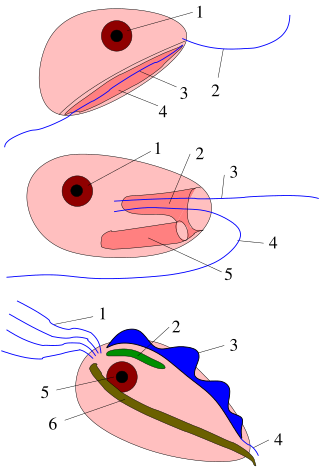
Excavata is an extensive and diverse but paraphyletic group of unicellular Eukaryota. The group was first suggested by Simpson and Patterson in 1999 and the name latinized and assigned a rank by Thomas Cavalier-Smith in 2002. It contains a variety of free-living and symbiotic protists, and includes some important parasites of humans such as Giardia and Trichomonas. Excavates were formerly considered to be included in the now obsolete Protista kingdom. They were distinguished from other lineages based on electron-microscopic information about how the cells are arranged. They are considered to be a basal flagellate lineage.
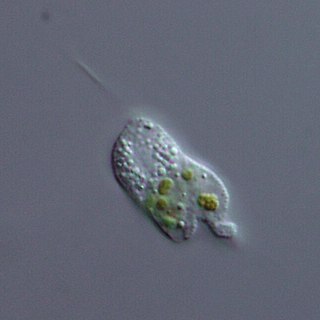
Cercozoa is a phylum of diverse single-celled eukaryotes. They lack shared morphological characteristics at the microscopic level, and are instead united by molecular phylogenies of rRNA and actin or polyubiquitin. They were the first major eukaryotic group to be recognized mainly through molecular phylogenies. They are the natural predators of many species of bacteria. They are closely related to the phylum Retaria, comprising amoeboids that usually have complex shells, and together form a supergroup called Rhizaria.

The parabasalids are a group of flagellated protists within the supergroup Excavata. Most of these eukaryotic organisms form a symbiotic relationship in animals. These include a variety of forms found in the intestines of termites and cockroaches, many of which have symbiotic bacteria that help them digest cellulose in woody plants. Other species within this supergroup are known parasites, and include human pathogens.
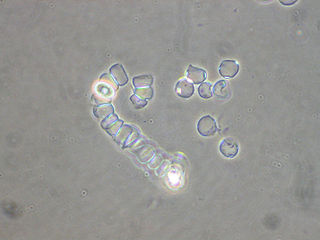
Discicristata is a proposed eukaryotic clade. It consists of Euglenozoa plus Percolozoa.

The tectofilosids are a group of filose amoebae with shells. These are composed of organic materials and sometimes collected debris, in contrast to the euglyphids, which produce shells from siliceous scales. The shell usually has a single opening, but in Amphitrema and a few other genera it has two on opposite ends. The cell itself occupies most of the shell. They are most often found on marsh plants such as Sphagnum.

The retortamonads are a small group of flagellates, most commonly found in the intestines of animals as commensals, although a free-living species called the Chilomastix cuspidata exists. They are grouped under the taxon Archezoa. They are usually around 5-20 μm in length, and all of their small subunit ribosomal RNA gene sequences are very similar to each other. There are two genera: Retortamonas with two flagella, and Chilomastix with four. In both cases there are four basal bodies anterior to a prominent feeding groove, and one flagellum is directed back through the cell, emerging from the groove.
The Oxymonads are a group of flagellated protists found exclusively in the intestines of animals, mostly termites and other wood-eating insects. Along with the similar parabasalid flagellates, they harbor the symbiotic bacteria that are responsible for breaking down cellulose. There is no evidence for presence of mitochondria in oxymonads and three species have been shown to completely lack any molecular markers of mitochondria.
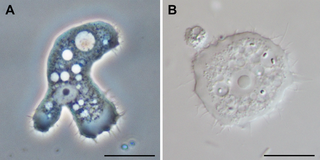
Discosea is a class of Amoebozoa, consisting of naked amoebae with a flattened, discoid body shape. Members of the group do not produce tubular or subcylindrical pseudopodia, like amoebae of the class Tubulinea. When a discosean is in motion, a transparent layer called hyaloplasm forms at the leading edge of the cell. In some discoseans, short "subpseudopodia" may be extended from this hyaloplasm, but the granular contents of the cell do not flow into these, as in true pseudopodia. Discosean amoebae lack hard shells, but some, like Cochliopodium and Korotnevella secrete intricate organic scales which may cover the upper (dorsal) surface of the cell. No species have flagella or flagellated stages of life.

Monadofilosa is a grouping of Cercozoa. These organisms are single-celled amoeboid protists.
Carpediemonas is genus of Metamonada, and belongs to the group Excavata. This organism is a unicellular flagellated eukaryote that was first discovered in substrate samples from the Great Barrier Reef. Carpediemonas can be found in anaerobic intertidal sediment, where it feeds on bacteria. A feature of this species is the presence of a feeding groove, a characteristic of the excavates. Like most other metamonads, Carpediemonas does not rely on an aerobic mitochondrion to produce energy. Instead, it contains hydrogenosomes that are used to produce ATP. This organism has two flagella: a posterior one used for feeding on the substrate, and an anterior one that moves in a slower sweeping motion. Carpediemonas is assigned to the fornicates, where similar Carpediemonas-like organisms are used in researching the evolution within excavates. Although Carpediemonas is a member of the metamonads, it is unusual in the sense that it is free-living and has three basal bodies.

Trichozoa is a group of excavates.
Trimastix is a genus of excavate protists, the sole occupant of the order Trimastigida. Trimastix are bacterivorous, free living and anaerobic. It was first observed in 1881 by William Kent. There are few known species, and the genus's role in the ecosystem is largely unknown. However, it is known that they generally live in marine environments within the tissues of decaying organisms to maintain an anoxic environment. Much interest in this group is related to its close association with other members of Preaxostyla. These organisms do not have classical mitochondria, and as such, much of the research involving these microbes is aimed at investigating the evolution of mitochondria.
Anaeromonadea, also known as Preaxostyla, is a class of excavate protists, comprising the oxymonads, Trimastix, and Paratrimastix. This group is studied as a model system for reductive evolution of mitochondria, because it includes both organisms with anaerobic mitochondrion-like organelles, and those that have completely lost their mitochondria.

Jakobids are an order of free-living, heterotrophic, flagellar eukaryotes in the supergroup Excavata. They are small, and can be found in aerobic and anaerobic environments. The order Jakobida, believed to be monophyletic, consists of only twenty species at present, and was classified as a group in 1993. There is ongoing research into the mitochondrial genomes of jakobids, which are unusually large and bacteria-like, evidence that jakobids may be important to the evolutionary history of eukaryotes.

Thecofilosea is a class of unicellular testate amoebae belonging to the phylum Cercozoa. They are amoeboflagellates, organisms with flagella and pseudopodia, distinguished from other cercozoa by their scale-lacking test composed of organic material. They are closely related to the Imbricatea, a group of testate amoebae with tests composed of inorganic silica scales.

The sarcomonads or class Sarcomonadea are a group of amoeboid biciliate protists in the phylum Cercozoa. They are characterized by a propensity to move through gliding on their posterior cilium or through filopodia, a lack of scales or external theca, a soft cell surface without obvious cortical filamentous or membranous skeleton, two cilia without scales or hairs, tubular mitochondrial cristae, near-spherical extrusomes, and a microbody attached to the nucleus.
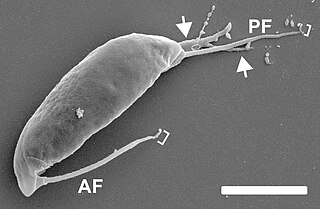
The apusomonads are a group of protozoan zooflagellates that glide on surfaces, and mostly consume prokaryotes. They are of particular evolutionary interest because they appear to be the sister group to the Opisthokonts, the clade that includes both animals and fungi. Together with the Breviatea, these form the Obazoa clade.
Tetratrichomonas undula is a species of parabasalid.
Endohelea is a proposed clade of eukaryotes that are related to Archaeplastida and the SAR supergroup. They used to be considered heliozoans, but phylogenetically they belong to a group of microorganisms known as Cryptista.









